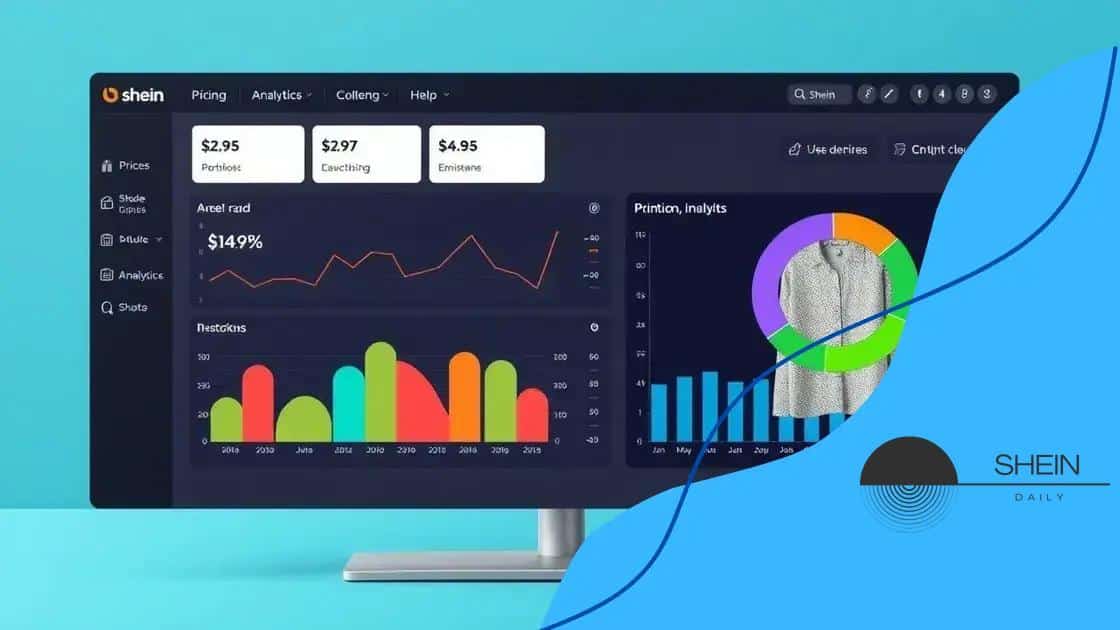How Shein uses data to optimize pricing models

Shein uses data analytics and competitor analysis to optimize pricing models, enabling real-time pricing adjustments and effective promotional strategies that enhance sales and customer satisfaction.
How Shein uses data to optimize pricing models is a fascinating topic that highlights the unique strategies behind their success. Have you ever wondered how they stay competitive in a fast-moving market? Let’s dive in and uncover their secrets.
Understanding Shein’s pricing strategy
Understanding Shein’s pricing strategy reveals how they keep their products affordable while maximizing sales. This balance is crucial in today’s fast-paced fashion industry. By leveraging data-driven insights, Shein ensures their pricing remains competitive and attractive to buyers.
Key Elements of Shein’s Pricing Strategy
At the core of Shein’s success are several essential components. They analyze customer behavior, market trends, and competitor pricing to determine optimal price points.
- Data Analytics: Shein utilizes data analytics to forecast demand and adjust prices accordingly.
- Dynamic Pricing: Prices change in real-time based on inventory levels and customer interactions.
- Promotions: Special discounts and flash sales are commonplace, attracting price-sensitive shoppers.
Another vital aspect is their focus on fast fashion. Shein often introduces new styles quickly, which demands a flexible pricing approach. This rapid turnover allows them to maintain relevance in a competitive marketplace.
Competitor Analysis
Understanding competitors’ pricing helps Shein position itself effectively in the market. They regularly track pricing strategies of similar brands. This awareness enables Shein to offer better deals and promotions to capture more market share.
Additionally, Shein employs a pricing model that often undercuts traditional retailers. This strategy is especially appealing for younger audiences looking for trendy apparel without overspending.
By committing to customer satisfaction, Shein has fostered loyalty through appealing price points. Their pricing strategy thrives on both affordability and quality, making them a go-to choice for many shoppers.
This combination of insights and strategies makes Shein a formidable player in the fashion industry. Their agile pricing approach, along with a keen understanding of market dynamics, showcases why they consistently perform well in sales.
Leveraging data analytics for pricing decisions
Leveraging data analytics for pricing decisions is a crucial strategy for businesses today. By harnessing the power of data, companies like Shein can make informed choices about how to set competitive prices. This practice not only boosts sales but also enhances customer satisfaction.
Understanding Customer Preferences
Data analytics allows Shein to gain insights into customer behavior and preferences. By analyzing purchasing patterns, they can determine which products are most popular. This knowledge enables them to adjust prices according to demand.
- Sales Data: Examining which items sell best helps in setting attractive price points.
- Customer Feedback: Surveys and reviews provide valuable insights into how customers perceive value.
- Market Trends: Analyzing trends helps predict future demand, allowing for proactive pricing strategies.
Moreover, Shein uses real-time data to react swiftly to market changes. This agility means they can alter prices based on inventory levels or shifts in consumer interest. If a particular style gains traction, adjusting the price can capitalize on that momentum.
The Role of Predictive Analytics
Predictive analytics is another powerful tool in Shein’s pricing strategy. By using algorithms that analyze historical data, they forecast future demand for specific items. This approach allows for smarter pricing that aligns with consumer trends.
This data-driven method leads to more effective pricing decisions. Instead of relying on guesswork, Shein can utilize data to create targeted offers that resonate with their audience. This strategy not only helps in maximizing profits but also ensures customers feel they are getting good deals.
As Shein continues to leverage data analytics, they remain competitive in the fast-paced fashion industry. The insights gained from data empower them to make strategic decisions that benefit both the business and the customer.
The role of competitor analysis in pricing

The role of competitor analysis in pricing is vital for any brand looking to succeed, especially in the fast fashion industry. Understanding what competitors are doing helps companies like Shein develop effective pricing strategies that attract consumers.
Identifying Competitor Pricing Strategies
Shein closely monitors their competitors to identify their pricing strategies. This information is crucial as it helps Shein position its products correctly in the market. By analyzing how similar brands price their items, Shein can determine where they fit in the competitive landscape.
- Price Matching: Shein adjusts prices to match or be lower than competitors to draw in price-conscious customers.
- Promotional Offers: They analyze the frequency and effectiveness of sales and discounts offered by competitors.
- Product Features: Understanding differences in product offerings leads to better pricing decisions.
In addition to analyzing prices, Shein looks at the overall marketplace. This includes trends in consumer preferences and seasonal changes. With this information, they can make informed decisions about pricing adjustments. For example, if a competitor has a major sale, Shein may choose to lower its prices to remain competitive.
The Impact of Competitor Pricing on Shein’s Decisions
Monitoring competitors does not just influence Shein’s pricing. It also affects product development and marketing strategies. The insights gained can lead to smarter merchandising choices that resonate with customers.
Shein seeks to offer something unique while ensuring their prices appeal to shoppers. This balance is critical for maintaining market share. By responding quickly to competitors, Shein can capitalize on trends before they vanish.
Through careful analysis and strategic pricing, Shein demonstrates how understanding the competition can foster growth and attract a loyal customer base. The swift changes in their pricing relative to competitor actions exemplify the importance of agility in business.
Real-time pricing adjustments at Shein
Real-time pricing adjustments at Shein demonstrate how agile pricing strategies can significantly impact sales. By utilizing advanced technology and data analytics, Shein can swiftly respond to market changes and customer behavior.
Understanding Real-Time Pricing
Real-time pricing allows Shein to alter prices based on various factors immediately. This means when a product is in high demand, they can increase the price to maximize profits. Conversely, if an item isn’t selling well, they may lower the price to encourage purchases.
- Dynamic Pricing: Algorithms analyze data to adjust prices continually, making them competitive.
- Inventory Levels: Prices can change depending on stock availability, ensuring sales even when items are running low.
- Customer Engagement: If customers show interest in a product, prices can be adjusted to retain their attention and motivate purchases.
Using real-time data helps Shein react faster than competitors. For example, during sales events or promotional campaigns, they can adjust prices instantly to attract more shoppers. This capability helps them to stay relevant and appealing to their target audience.
The Technology Behind Real-Time Pricing
Many factors come into play when implementing real-time pricing. Shein deploys sophisticated algorithms that continuously analyze data from various sources, such as customer purchasing patterns and competitor prices. These insights allow for more effective pricing decisions, leading to better sales outcomes.
This approach means that Shein does not have to wait for traditional reporting cycles to make pricing decisions. Instead, they can respond in the moment, capitalizing on trends as they arise. This responsiveness is essential in the fast fashion industry, where preferences can change rapidly.
Ultimately, Shein’s ability to make real-time pricing adjustments showcases their innovative approach to retail. By embracing technology and data analytics, they ensure they remain competitive while catering to a diverse customer base.
Case studies of successful pricing models
Case studies of successful pricing models provide valuable insights into how companies can optimize their strategies. One of the standout examples is Shein, which has effectively navigated the competitive landscape of fast fashion through innovative pricing techniques.
Shein’s Promotional Strategy
Shein successfully employs a mix of promotional strategies that capture consumer interest. By offering limited-time discounts and flash sales, they create urgency, encouraging customers to make quick purchases. This model not only boosts short-term sales but also enhances brand loyalty.
- Discount Codes: Frequent promotions attract new customers while keeping existing ones engaged.
- Seasonal Sales: Aligning sales with seasonal trends maximizes relevance and shopping excitement.
- Referral Programs: Incentivizing current customers to bring in friends helps expand their customer base effectively.
Each of these strategies shows how Shein successfully tailors its approach to meet and react to market demands. By analyzing customer behavior and preferences, they adjust their pricing in real-time, ensuring they remain competitive.
Dynamic Pricing in Action
Another successful aspect of Shein’s pricing model is its use of dynamic pricing based on data analytics. This technique allows Shein to modify prices spontaneously based on inventory levels, demand, and competitor actions. For example, if a particular item is selling quickly, the price may increase to leverage higher demand.
On the other hand, items that do not attract enough attention might see price reductions to kickstart sales. This responsive pricing strategy not only optimizes profits but also aligns with consumer expectations for value.
Through these case studies, it’s clear that effective pricing models are rooted in understanding the market and the customer. Shein’s ability to adapt quickly and precisely to market changes showcases the benefits of a well-crafted pricing strategy.
In conclusion, understanding how Shein utilizes data to optimize pricing models provides important lessons for businesses. Their approach of leveraging data analytics allows them to make smart, real-time decisions that appeal to consumers. By continuously monitoring competitor pricing and consumer behavior, Shein creates a dynamic pricing strategy that leads to higher sales and customer satisfaction. Overall, innovative pricing strategies play a crucial role in achieving success in a competitive marketplace.
FAQ – Frequently Asked Questions about Shein’s Pricing Models
How does Shein utilize data for pricing decisions?
Shein leverages data analytics to make informed pricing decisions based on customer behavior, market trends, and competitor pricing.
What are real-time pricing adjustments?
Real-time pricing adjustments allow Shein to change prices instantly according to inventory levels and demand, ensuring competitiveness.
Why is competitor analysis important for pricing?
Competitor analysis helps Shein understand market positioning and adjust its prices to attract more customers and remain competitive.
What promotional strategies does Shein use?
Shein employs limited-time offers, discount codes, and referral programs to boost sales and engage customers effectively.





